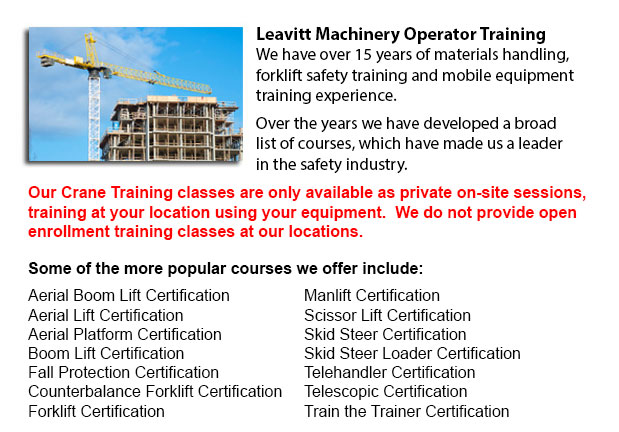
Overhead Crane Safety Training Glendale - Overhead crane safety training equips operators with knowledge and skills regarding crane safety measures, accident avoidance, materials handling, and machinery and stock protection. Trainees would learn the kinds of overhead cranes, their capabilities and their uses in various industry settings. For operators who are licensed and trained, the shift in liability moves to the operator from the company. Therefore, the course emphasizes individual operator duties.
Overhead crane safety training instructs operators in the right techniques for performing checks. Two kinds of pre-shift inspection are the walk-around inspection and the in-depth inspection. These are vital daily routines that must be logged. Properly recorded pre-shift checks help to protect the company from liability in the event of an accident. Pre-shift checks likewise prevent costly repairs, accidents and damage. Operators learn how to designate a specific individual to perform checks, how to report problems, and how to maintain the log book.
Each and every check should be documented and carried out regularly. Things which should be inspected for possible problems, comprise: hooks for cracks, increases in the throat opening, hoist ropes for corrosion, degree of twist, loss of diameter, worn wires, broken wires, bird caging and kinks, chains for nicks and gouges, heat and chemical damage, twists, cracks and corrosion, distortion, excessive wear, pits, stretching, damage caused by extreme heat.
Operators learn proper rigging procedures in this program. Rigging involves understanding the manufacturer's data plate, determining the material weight to be lifted, selecting the gear, and using safe practices to secure the load. The course cover in detail the following: safe working loads, and the capacities of ropes, chains, slings, hooks and shackles.
It is essential to know who could operate the cranes at your facility, the job's physical requirements, and operator qualifications required for permits and specialized tasks. Safety should be prioritized when operating in the vicinity of pedestrian traffic.
Safe crane operation includes duties like undertaking visual inspections, checking for hydraulic leaks, testing the controls, checking the safety guards, examining the hoist rope and hook, limit switches and braking mechanisms. Right reporting methods are critical. These subject matters are all included in depth in the program.
Proper lifting and moving methods with cranes and hoists are included in the program. Operators would become competent in hand signals. Training includes how to raise the load, attach the load, set the load, unhook the slings and abort a lift.
Moving the load includes several steps: starting and stopping procedures, guiding and controlling the load, working with signals and observing working conditions. Operators need to know how to proceed in the event of a power failure. The course covers methods for lowering the load and removing the slings, parking the crane, storage equipment, and securing an outdoor and indoor crane.
-
Aerial Lift Train the Trainer Glendale
Aerial Lift Train the Trainer Glendale - The Aerial Lifts Train the Trainer Certification Program will teach trainers how to effectively train operators in safe industrial mobile machine operation. Trainers are given in-depth instruction on aerial li... More -
Forklift License Glendale
Forklift License Glendale - In North America, acquiring a forklift license or forklift certification involves hands-on and classroom training. Regulatory control over certification, training and license for powered industrial truck operators falls un... More -
Telehandler Certification Glendale
Telehandler Certification Glendale - Telehandler certification programs are both for operators who have some experience driving a typical forklift and for individuals with no experience. The real-world training provided by these courses produces grad... More -
Operator Safety Training and Re-Qualification Training and In-House Instructor Training in Glendale
Forklifts are used in almost all warehouse operations and in boat yards and in industrial construction sites. The reach feature of a forklift is a very important component utilized in a variety of applications like for example when a shelving system... More -
Manlift Training Glendale
Manlift Training Glendale - Different manlift training programs include the content and review of manlift devices. An important portion of the program is the practicum where students show their practical ability and knowledge to safely operate a manl... More -
Crane Certification Glendale
Crane Certification Glendale - The Crane Certification Program consists of the industry suggested subject matter which will teach the safe and efficient operation of cranes. The individual would train in the following: how to identify cranes and thei... More -
Loader Ticket Glendale
Loader Ticket Glendale - Gehl articulated loaders have been made to suit practically every condition. They offer optimal maneuverability and great traction due to a heavy-duty oscillating joint that provides 45-degree rotating angles right and left,... More -
Crane Ticket Glendale
Crane Ticket Glendale - The new version of a crane could be either simple or complex, and cranes vary based on their use. Mobile cranes, for instance are rather simple. A telescopic boom or steel truss mounts its movable platform. A system of levers... More

Forklift Training Glendale
TOLL FREE: 1-888-254-6157
Glendale, Arizona
forkliftcertificationglendale.com
Email Us
About Us


